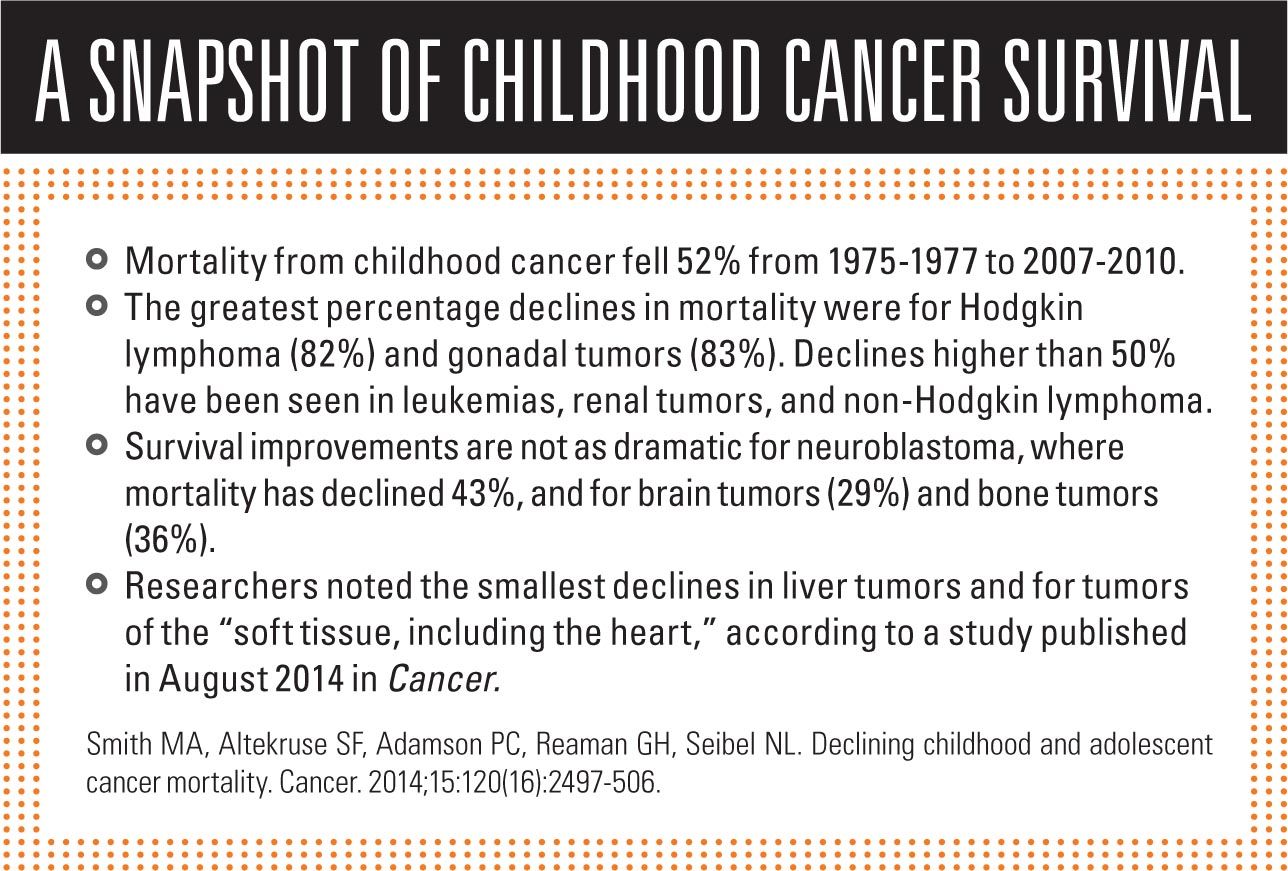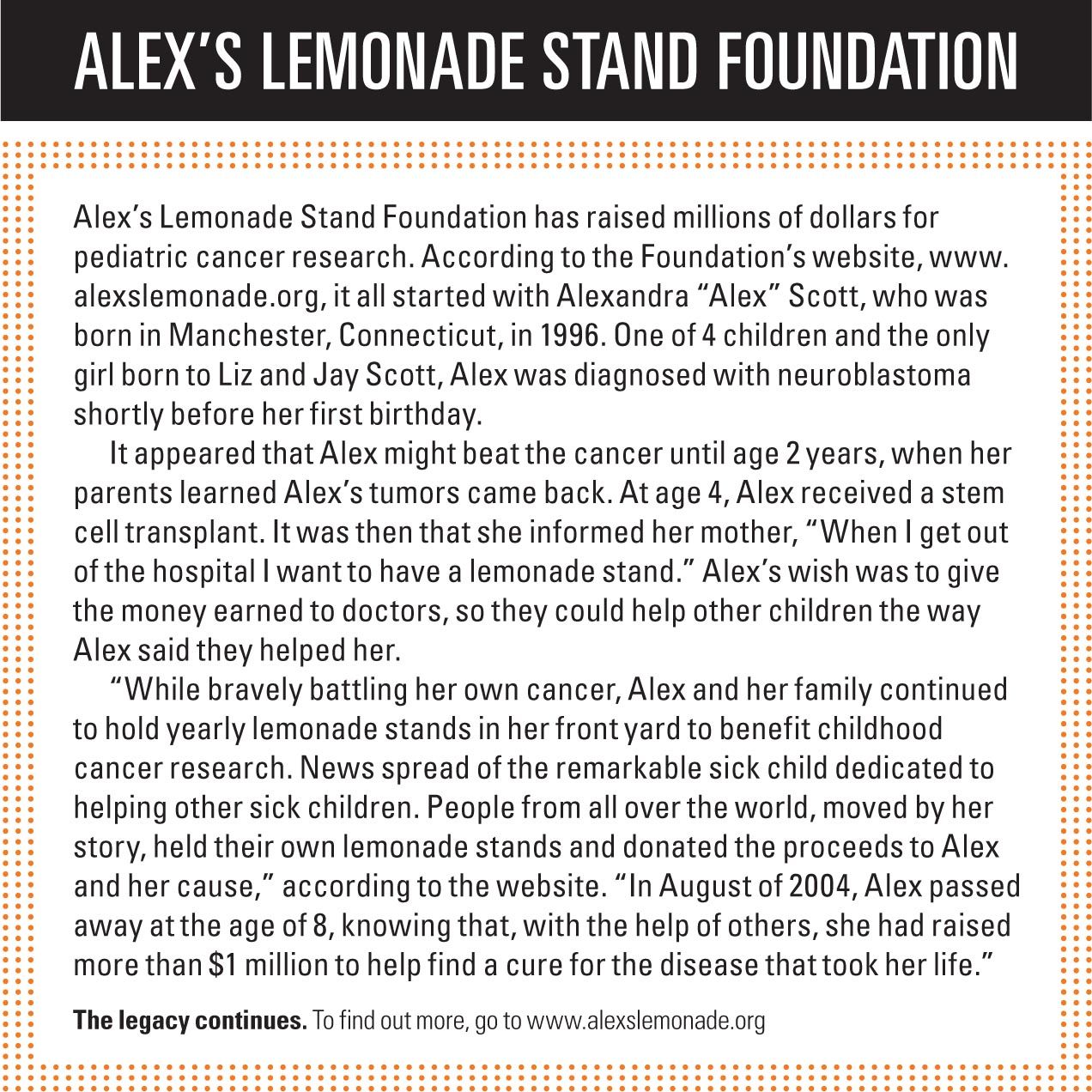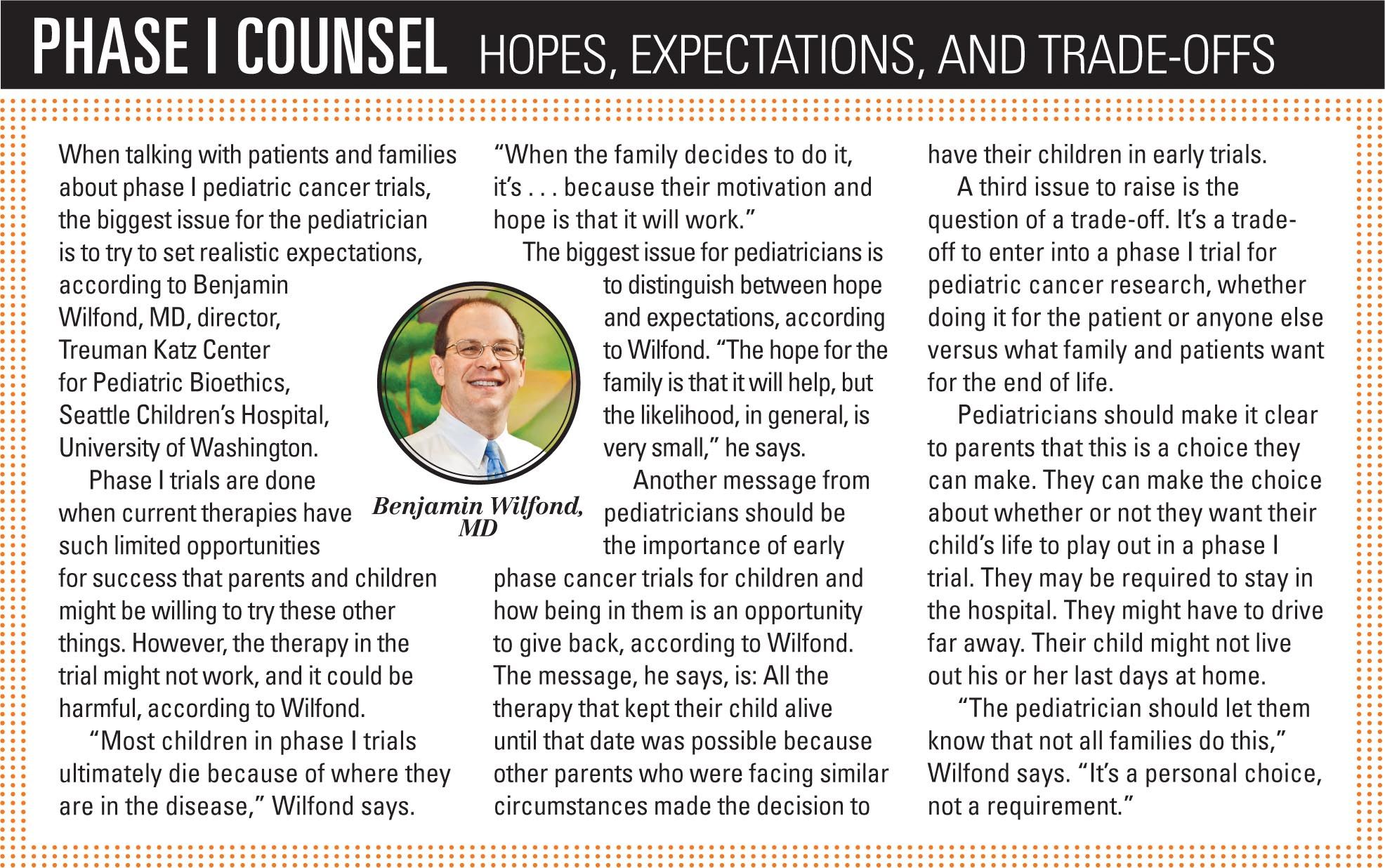Phase I clinical trials test new therapies for kids’ cancers
Early phase pediatric cancer trials offer hope to children whose cancer defies standard therapy.
Children’s cancer treatment has come a long way. Pediatric oncology is one of the biggest success stories in medical, and certainly cancer, research, says Stacey L. Berg, MD, pediatric oncologist at Texas Children’s Cancer Center and professor of pediatric hematology and oncology at Baylor College of Medicine, Houston, Texas.
“The very good news is somewhere over 80% of the children who are diagnosed with cancer are actually able to be cured with the therapies we have now,” Berg says.

Stacey L. Berg, MDIn fact, a drastic improvement in the overall outlook for children with cancer has occurred in the last half century. In 1975, slightly more than half of children diagnosed with cancer before age 20 years survived at least 5 years.1 In 2004 to 2010, more than 80% of children diagnosed with cancer before age 20 years survived at least 5 years.2 Yet there’s more work to be done.
“[The] significant, unintended, late effects of current curative therapies result in serious chronic morbidity in 2 out of every 3 survivors of childhood cancer.3 For children and adolescents who experience a recurrence or relapse of cancer, many will die as the result of progression of cancer that is unresponsive to current therapies,” says Elizabeth Fox, MD, associate professor of pediatrics, Perelman School of Medicine at the University of Pennsylvania, and head of the developmental therapeutics program for childhood cancer research at the Children’s Hospital of Philadelphia.
Uncovering new options with early phase research
Although most newly diagnosed children with cancer participate in phase III studies, which test standard treatments against promising alternatives, the phase I and II trials stand to help the 20% or so of children who aren’t cured or whose cancer returns. The goal of phase I trials is to evaluate dosages and treatment safety. Phase II studies identify which tumors respond favorably to the new drug or treatment.

The earliest an oncology drug would become available to patients is in the context of a phase I trial, according to Berg.
There are thousands of pediatric cancer patients who run out of treatment options each year, given that an estimated 15,780 children and adolescents will have been diagnosed with cancer in 2014.4 Although cancer in children is rare, it is the leading cause of death by disease past infancy among children in the United States. Nearly 2000 US children and adolescents will die of the disease in 2014.
“Early phase clinical trials are one of those things where we’re . . . trying [in order] to put ourselves out of business, by getting into a situation where standard therapies can help everybody. That’s not the case right now,” Berg says. “There’s a big need for developing new drugs and new treatments that will let us help children that we don’t have good therapy for right now. And then hopefully in the future, these new therapies will become standard and help people at the time of diagnosis.”
The curability of pediatric cancers, just like adult cancers, is uneven. While the cure rate for some kinds of leukemia is as high as 95%, cures are much less likely for children with other cancer types.
According to the American Cancer Society, the most common types of cancer diagnosed in children and adolescents are leukemia; brain and central nervous system tumors; lymphoma; rhabdomyosarcoma; neuroblastoma; Wilms tumor; retinoblastoma; and bone cancer.5
“One of the most difficult groups of cancer for us to treat is some kinds of brain tumors,” Berg says. “Other tumors that are difficult to treat are solid tumors that either have spread widely throughout the body at the time of diagnosis or that recur or return after initial treatment. Those are areas where there is a lot of activity in terms of research to develop new therapies.”
Early phase pediatric cancer research has its success stories. One example of a novel therapy developed for children with cancer is dinutuximab, a chimeric antibody that targets the ganglioside D2 molecule found on the surface of neuroblastoma cells, according to Fox.

Elizabeth Fox, MD“High risk neuroblastoma occurs in young children and is characterized by wide dissemination of disease at diagnosis. [These children] have very poor prognosis even with intensive multimodality therapy,” Fox says. “Dinutuximab was developed as a collaboration of physician-scientists in pediatric oncology research teams, the National Cancer Institute (NCI; Bethesda, Maryland), the Children’s Oncology Group (COG), and the pharmaceutical industry (United Therapeutics; Silver Springs, Maryland). By combining dinutuximab with other drugs that stimulate the immune system, the 2-year event-free survival for selected children with high-risk neuroblastoma was improved from 46% to 66%.”6
Research trends
A primary trend in today’s cancer research is the study of molecular targeted agents, with the goal of matching a molecularly targeted agent to the genomic alterations that a particular child has in his or her cancer, according to Malcolm A. Smith, MD, PhD, associate branch chief for pediatrics in the Cancer Therapy Evaluation Program, NCI.
“This is the concept of precision medicine, in which we try to find the right drug for the right patient,” Smith says. “We have trials that we have conducted or are conducting in which we have a targeted agent that acts to inhibit a particular cancer driver inside the cancer cells. If we have patients who have the cancer gene driver turned on, the agent can be quite effective.”

Malcolm A. Smith, MD, PhDOne example, according to Smith, is the agent crizotinib, an anaplastic lymphoma kinase (ALK) inhibitor. “[It’s] an effective treatment for the approximately 5% of lung cancer patients who have a genomic alternation in the ALK gene, which makes them especially sensitive to crizotinib,” Smith says. “Within the pediatric population, we have a group of patients with anaplastic large cell lymphomas who also have genomic alterations in the ALK gene. When these patients were treated with crizotinib in a phase I trial, among the 9 patients treated with this diagnosis, 8 showed a high degree of tumor regression.7 That’s a very promising result.”
This potential breakthrough would make a big difference in the lives of some children with anaplastic large cell lymphoma, according to Peter C. Adamson, MD, professor of pediatrics and pharmacology at the University of Pennsylvania, Children’s Hospital of Philadelphia.
“[For] over 20 years, we’ve known the molecular cause [of anaplastic large cell lymphoma] but haven’t been able to take that molecular cause and find a new treatment. Historically, it has been treated with relatively intensive chemotherapy. Despite numerous variations in that intensive chemotherapy, we still only have 70% of children who are 5-year event-free survivors. In essence, 30% of children with anaplastic large cell lymphoma, despite our efforts, would succumb to the disease,” Adamson says.
In addition to crizotinib, another drug is showing promise in treating children with the cancer type who have relapsed, according to Adamson. It’s a conjugated antibody called brentuximab vedotin.
“[In an ongoing phase II trial,] children are being randomized to receive chemotherapy plus 1 of the 2 drugs because both drugs appear very effective in the relapse setting. One goal is to determine whether we can combine the new drugs with effective chemotherapy but, more importantly, another goal is to find out if addition of a targeted new agent is going to be able to push the needle away from the 70% event-free survival rate that we’ve been stuck at for too long,” Adamson says.
Immunotherapy includes novel therapies that modify the child’s own T-cells to fight cancer, according to Fox. “There is a growing number of clinical trials evaluating chimeric antigen receptor (CAR) T-cell therapies in leukemia and solid tumors in children and adolescents. In addition, vaccines for childhood cancer therapy and oncolytic virus therapies have been evaluated as new therapeutic approaches,” he says.
As new agents become more specific and target molecular characteristics of specific cancers, clinical trial enrollment may be restricted to children with relapsed cancer that harbor selected mutations, according to Fox.
“We may need a change in thinking about caring for children and adolescents with cancers that are metastatic at diagnosis, have high-risk clinical phenotypes, or have a high likelihood of recurring or being refractory to standard therapy,” Fox says. “For these children and adolescents, discussions about future therapeutic options are never premature. Early discussion may help patients, families, and primary care physicians sort through the vast amount of information available on the Internet. Preliminary discussions may help preserve options for patients in the future or facilitate referral for enrollment, if needed.”

Access to early trials
Phase I pediatric cancer trials are generally small, with approximately 20 to 30 participants in each trial. However, they’re complex, difficult to administer, and expensive, so most (if not all) of these early phase trials are in large children’s or academic hospitals. One of the reasons that pediatric phase 1 trials are relatively small is that dosing begins at dose levels very close to the recommended adult dose. Hence, only 1 or 2 higher dose levels typically need to be evaluated, according to Smith.
The NCI directly supports phase I pediatric cancer research primarily through 2 avenues: the COG Phase I and Pilot Consortium, and the Pediatric Brain Tumor Consortium. The NCI also provides funding for early research to New Approaches to Neuroblastoma Therapy (NANT).
“One of the goals of those 2 groups was to be able to spread, somewhat geographically, the availability of early phase clinical trials,” says Berg, who is vice chair for regulatory affairs of the COG’s Phase I and Pilot Consortium.
The COG Phase I and Pilot Consortium, launched in 2002, is made up of 21 pediatric oncology programs in the United States that were selected in a peer review process, according to the COG website, www.ChildrensOncologyGroup.org. The COG’s Phase I and Pilot Consortium is part of the larger COG, which conducts all phases of pediatric cancer research and has more than 8000 experts worldwide and nearly 100 active clinical-translational trials open at any given time. More than 90% of US children and adolescents diagnosed with cancer each year are cared for at COG member institutions, according to the website.
The NCI formed the Pediatric Brain Tumor Consortium in 1999 to improve primary brain tumor treatment in children. Its primary goal is to rapidly conduct novel phase I and phase II clinical evaluations of new therapeutic drugs, new biological therapies, treatment delivery technologies, and radiation treatment strategies in children from infancy to age 21 years.

“One of the reasons for having small consortia is that these studies are extremely hard to do,“ Berg says. “They take a lot of expertise by the doctors, research staff, and the institutions themselves. They also take a huge amount of resources. You have to have a whole dedicated research staff. It’s very helpful to have a special kind of research unit in the hospital. You have to have regulatory staff who know how to do all the paperwork properly because, for safety and ethical reasons, this is very highly regulated research.” He continues, “Although the National Cancer Institute does pay the institutions to some extent to support the research that’s being done, there’s also a big contribution from the institution. [T]hat’s not in reach of every institution.”
Funding sources
Phase I pediatric cancer trials are primarily funded by government institutions that do the research and philanthropy, according to Berg.
“We were very fortunate to become funded as what’s called a developmental therapeutic center of excellence by Alex’s Lemonade Stand Foundation. There are currently 4 of those centers in the country,” Berg says. Government funding for phase I pediatric cancer trials has been stable over the last few years, with some modest increases, according to Smith.

Private industry is less likely than these other sources to finance early childhood cancer trials. “If you only look at the purely economic reasons to develop new drugs just for children with cancer, you might say it’s not that big a market, so big pharma wouldn’t be that interested. Recognizing this problem, Congress (over the last 20 years) enacted a series of bills that provide incentives for industry to develop drugs for children,” Berg says.
The legislation, including such laws as the Best Pharmaceuticals for Children’s Act, provides financial incentives for companies to allow their new drugs to be tested in children with various illnesses. In return, the companies benefit with things such as patent extensions, according to Berg.
The incentives might not be enough, however. “The rarity of childhood cancer means that industry is not going out and developing a drug for children with cancer. There is not an economic model for doing that. There are regulatory and financial incentives that may help, but the fact of the matter is industry does not set out to develop a drug first for children with cancer,” Adamson says.
Barriers to pediatric research
Doctors who conduct phase I pediatric cancer trials say one of the biggest barriers is being able to study drugs in children that have shown promise in adult cancers. “That is partly because of the regulatory burden and partly because the companies can be very conservative in their plans for moving new drugs into pediatrics,” Berg says.

Robin Norris, MDRobin Norris, MD, a pediatric oncologist and assistant professor of pediatrics, Case Western Reserve University, Cleveland, Ohio, agrees that access to drugs is a barrier to pediatric cancer research. “I think our biggest limitation is actually the number of trials and the number of agents that we, as pediatric oncologists, have access to. There are a lot of phase I studies that are geared toward the adult population but a lot of those agents are not available to children under the age of 18,” she says.
By contrast, drug development for adult cancers has expanded far beyond where it was 25 years ago, according to Adamson. “There are probably well over 500 drugs in the adult cancer development pipeline. Clearly not all those drugs are going to be relevant for children with cancer and we couldn’t possibly test all of them in children with cancer,” he says.
One of the challenges is determining which of the drugs being developed for adult cancers might make sense for children with cancer, Adamson says.
Patients and their families also face challenges when they attempt to get involved in pediatric cancer trials. Among the challenges for families: financial burden and geographic barriers, Berg says. Enrolling in a trial might require a family to temporarily relocate, and, if they cross state lines, Medicaid and some insurers might not pick up the tab, according to Berg.

Pediatricians in the mix
While children in pediatric cancer phase I trials receive their treatment at participating cancer centers and children’s hospitals, these children’s long-term health is dependent on a multidisciplinary team that includes community pediatricians, Berg says.
For pediatricians who suspect any of their patients have cancer, the most important first step, according to Adamson, is to refer these children to pediatric oncologists for evaluations. It’s best to steer children to pediatric oncologists at centers that can provide multimodality therapy.
“Most childhood cancer therapy takes more than a pediatric oncologist. It takes a team, including pediatric surgeons, pediatric radiation therapists, pediatric radiologists, social workers, [and] pediatric oncology nurses,” Adamson says. “With that said, it is a partnership with pediatricians because much of our treatment is protracted and follow-up is essentially lifelong.”
Managing adverse effects in pediatric cancer survivors is an important role for community pediatricians, according to Adamson. Despite the survival success in pediatric cancer therapy today, it’s no secret that these children often experience lifelong health consequences from the life-saving therapies.
“It’s not only during treatment that we need to partner with pediatricians to monitor acute effects. It's also critically important for the children who are survivors that we are able to detect, monitor for, and treat any of the long-term effects of our therapy,” Adamson says.
Phase I trials aren’t for every family, according to Smith. Doctors and their patients and families should talk at length about whether early phase research is in a child’s best interests, he says. “There’s a personal decision-one that needs to be carefully discussed with the family. Some children derive substantial clinical benefit from participation in a phase 1 study, although overall the percentage of children who show clinical benefit is small. For some families, it can be an important option to have.”
An important and often comforting aspect of early phase pediatric research, according to Norris, is that almost all phase I therapies in children have been tested in adults. “In adult phase I studies, some new drugs are being tested for the first time in humans. In pediatric patients, the drugs have been studied in adult patients. So, we know the safety data,” Norris says. “Typically [in early phase pediatric trials], we start with a dose that’s about 75% of that studied in the adult population. In general, kids tolerate new agents as well if not better than the adult population.”
Norris was recruited to Case Western Reserve’s affiliated University Hospitals Rainbow Babies and Children’s Hospital to launch a pediatric developmental therapeutic program. “The clinical piece of our developmental therapeutics program is to run early phase clinical research-phase I and phase II trials. We currently have 12 early phase clinical trials open. We have phase I and [phase] II studies for patients with relapsed or refractory solid tumors, as well as for patients who relapsed, or refractory leukemias or lymphomas,” she says.
Awareness among pediatricians, patients, and their families about the importance of early phase pediatric cancer trials is key, according to Norris. “[We] really need to find better drugs for kids with cancer,” she says. “It is incredibly frustrating and heart-wrenching as a pediatric oncologist to care for our patients and not have a good answer when they look at us and say, ‘What can you do to help me get rid of this?’”
REFERENCES
1. Ries LAG, Smith MA, Gurney JG, et al. (eds). Cancer Incidence and Survival Among Children and Adolescents: United States SEER Program 1975-1995. NIH Pub. No. 99-4649. Bethesda, MD: National Cancer Institute; 1999. Available at: http://seer.cancer.gov/archive/publications/childhood/. Accessed August 21, 2014.
2. Howlader N, Noone AM, Krapcho M, et al. (eds). SEER Cancer Statistics Review, 1975-2011. (Based on November 2013 SEER data submission.) Bethesda, MD: National Cancer Institute; 2014. Available at: http://seer.cancer.gov/csr/1975_2011/, Posted April 2014. Updated May 12, 2014. Accessed August 21, 2014.
3. American Academy of Pediatrics Section on Hematology/Oncology Children's Oncology Group. Long-term follow-up care for pediatric cancer survivors. Pediatrics. 2009;123(3):906-915.
4. Ward E, DeSantis C, Robbins A, Kohler B, Jemal A. Childhood and adolescent cancer statistics, 2014. CA Cancer J Clin. 2014;64(2):83-103.
5. American Cancer Society. Cancer in children. American Cancer Society website. Available at: www.cancer.org/cancer/cancerinchildren/detailedguide/cancer-in-children-types-of-childhood-cancers. Reviewed September 5, 2013. Revised January 31, 2014. Accessed August 21, 2014.
6. Yu AL, Gilman AL, Ozkaynak MF, et al; Children's Oncology Group. Anti-GD2 antibody with GM-CSF, interleukin-2, and isotretinoin for neuroblastoma. N Engl J Med. 2010;363(14):1324-1334.
7. Mossé YP, Lim MS, Voss SD, et al. Safety and activity of crizotinib for paediatric patients with refractory solid tumours or anaplastic large-cell lymphoma: a Children's Oncology Group phase 1 consortium study. Lancet Oncol. 2013;14(6):472-480.
Alex’s Lemonade Stand Foundation
Alex’s Lemonade Stand Foundation has raised millions of dollars for pediatric cancer research. According to the Foundation’s website, www.alexslemonade.org, it all started with Alexandra “Alex” Scott, who was born in Manchester, Connecticut, in 1996. One of 4 children and the only girl born to Liz and Jay Scott, Alex was diagnosed with neuroblastoma shortly before her first birthday.
It appeared that Alex might beat the cancer until age 2 years, when her parents learned Alex’s tumors came back. At age 4, Alex received a stem cell transplant. It was then that she informed her mother, "When I get out of the hospital I want to have a lemonade stand." Alex’s wish was to give the money earned to doctors, so they could help other children the way Alex said they helped her.
“While bravely battling her own cancer, Alex and her family continued to hold yearly lemonade stands in her front yard to benefit childhood cancer research. News spread of the remarkable sick child dedicated to helping other sick children. People from all over the world, moved by her story, held their own lemonade stands and donated the proceeds to Alex and her cause,” according to the website. “In August of 2004, Alex passed away at the age of 8, knowing that, with the help of others, she had raised more than $1 million to help find a cure for the disease that took her life.”
The legacy continues. To find out more, go to www.alexslemonade.org.
Early phase pediatric cancer resources
Children’s Oncology Group Phase I and Pilot Consortium:
Thalia Beeles, MPH
Operations Director
222 E. Huntington Drive, Suite 100
Monrovia, CA 91016
Tel: 626.241.1630
Fax: 626.445.4334
E-mail: tbeeles@childrensoncologygroup.org
www.childrensoncologygroup.org/index.php/phase-1-home
Pediatric Brain Tumor Consortium:
National Cancer Institute (NCI):
Searchable, comprehensive national repository on clinical trials:
NCI’s Cancer Therapy Evaluation Program (CTEP):
Childhood cancer research resources:
http://ctep.cancer.gov/investigatorResources/childhood_cancer/
Texas Children’s Cancer Center:
Stacey L. Berg, MD, and staff
Tel: 832.824.4588
E-mail: sberg@txch.org
New Approaches to Neuroblastoma (NANT):
Ms Hilton is a medical writer who has covered health and medicine for 25 years. She resides in Boca Raton, Florida. She has nothing to disclose in regard to affiliations with or financial interests in any organizations that may have an interest in any part of this article.
Having "the talk" with teen patients
June 17th 2022A visit with a pediatric clinician is an ideal time to ensure that a teenager knows the correct information, has the opportunity to make certain contraceptive choices, and instill the knowledge that the pediatric office is a safe place to come for help.
Meet the Board: Vivian P. Hernandez-Trujillo, MD, FAAP, FAAAAI, FACAAI
May 20th 2022Contemporary Pediatrics sat down with one of our newest editorial advisory board members: Vivian P. Hernandez-Trujillo, MD, FAAP, FAAAAI, FACAAI to discuss what led to her career in medicine and what she thinks the future holds for pediatrics.